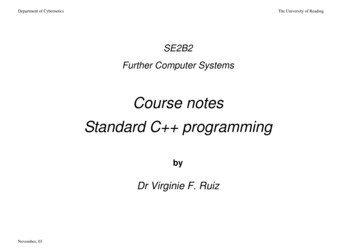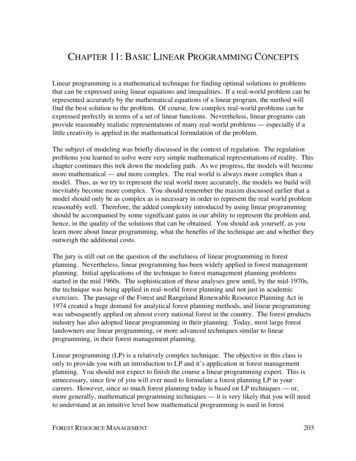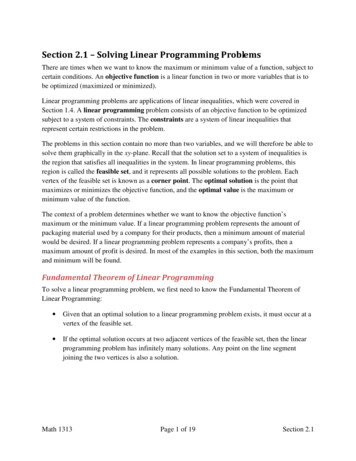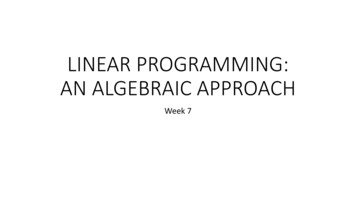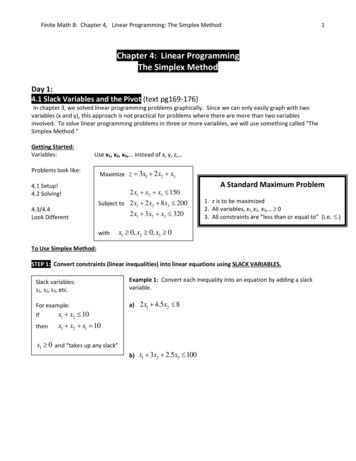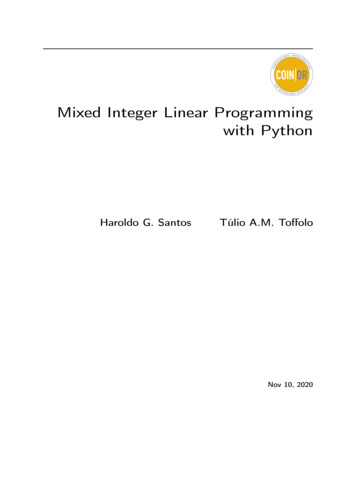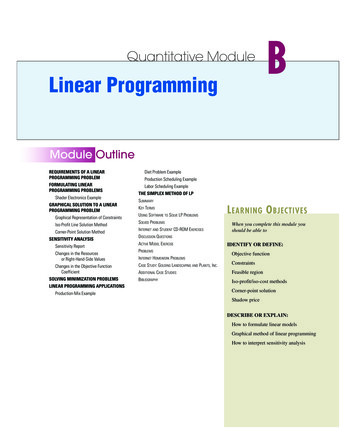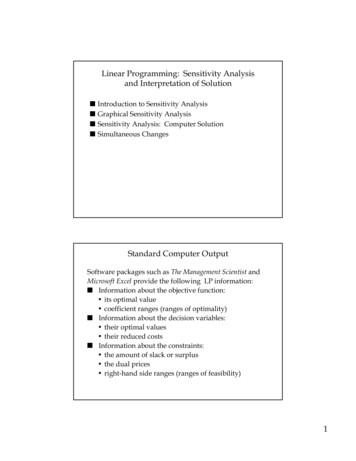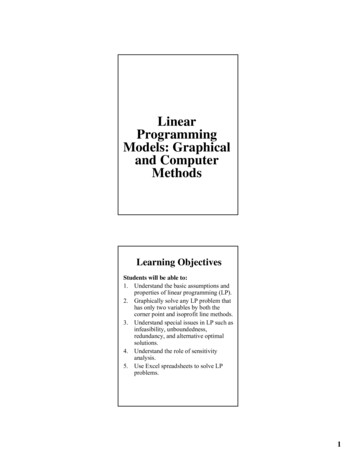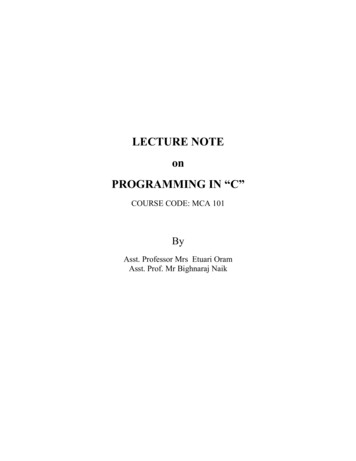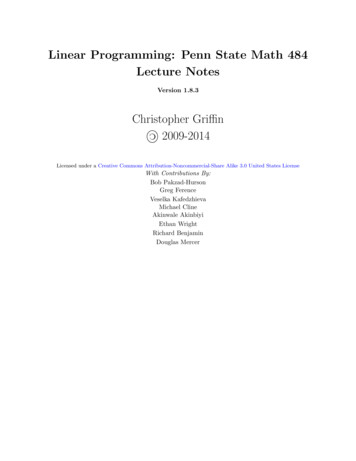
Transcription
Linear Programming: Penn State Math 484Lecture NotesVersion 1.8.3Christopher Griffin« 2009-2014Licensed under a Creative Commons Attribution-Noncommercial-Share Alike 3.0 United States LicenseWith Contributions By:Bob Pakzad-HursonGreg FerenceVeselka KafedzhievaMichael ClineAkinwale AkinbiyiEthan WrightRichard BenjaminDouglas Mercer
ContentsList of FiguresvPrefaceixChapter 1. Introduction to Optimization1. A General Maximization Formulation2. Some Geometry for Optimization3. Gradients, Constraints and Optimization12410Chapter 2. Simple Linear Programming Problems1. Modeling Assumptions in Linear Programming2. Graphically Solving Linear Programs Problems with Two Variables (BoundedCase)3. Formalizing The Graphical Method4. Problems with Alternative Optimal Solutions5. Problems with No Solution6. Problems with Unbounded Feasible Regions1314Chapter 3. Matrices, Linear Algebra and Linear Programming1. Matrices2. Special Matrices and Vectors3. Matrices and Linear Programming Expression4. Gauss-Jordan Elimination and Solution to Linear Equations5. Matrix Inverse6. Solution of Linear Equations7. Linear Combinations, Span, Linear Independence8. Basis9. Rank10. Solving Systems with More Variables than Equations11. Solving Linear Programs with Matlab272729303335373941434547Chapter 4. Convex Sets, Functions and Cones and Polyhedral Theory1. Convex Sets2. Convex and Concave Functions3. Polyhedral Sets4. Rays and Directions5. Directions of Polyhedral Sets6. Extreme Points7. Extreme Directions5151525356575962iii1617182022
8. Caratheodory Characterization TheoremChapter 5. The Simplex Method1. Linear Programming and Extreme Points2. Algorithmic Characterization of Extreme Points3. The Simplex Algorithm–Algebraic Form4. Simplex Method–Tableau Form5. Identifying Unboundedness6. Identifying Alternative Optimal Solutions7. Degeneracy and Convergence646969707178818486Chapter 6. Simplex Initialization1. Artificial Variables2. The Two-Phase Simplex Algorithm3. The Big-M Method4. The Single Artificial Variable Technique5. Problems that Can’t be Initialized by Hand91919598102103Chapter 7. Degeneracy and Convergence1. Degeneracy Revisited2. The Lexicographic Minimum Ratio Leaving Variable Rule3. Bland’s Rule, Entering Variable Rules and Other Considerations109109111116Chapter 8. The Revised Simplex Method and Optimality Conditions1. The Revised Simplex Method2. Farkas’ Lemma and Theorems of the Alternative3. The Karush-Kuhn-Tucker Conditions4. Relating the KKT Conditions to the Tableau117117121126132Chapter 9. Duality1. The Dual Problem2. Weak Duality3. Strong Duality4. Geometry of the Dual Problem5. Economic Interpretation of the Dual Problem6. The Dual Simplex Method137137141142145148152Bibliography157iv
List of Figures1.11.21.31.41.5Goat pen with unknown side lengths. The objective is to identify the values ofx and y that maximize the area of the pen (and thus the number of goats thatcan be kept).2Plot with Level Sets Projected on the Graph of z. The level sets existing in R2while the graph of z existing R3 . The level sets have been projected onto theirappropriate heights on the graph.5Contour Plot of z x2 y 2 . The circles in R2 are the level sets of the function.The lighter the circle hue, the higher the value of c that defines the level set.6A Line Function: The points in the graph shown in this figure are in the setproduced using the expression x0 vt where x0 (2, 1) and let v (2, 2).6A Level Curve Plot with Gradient Vector: We’ve scaled the gradient vectorin this case to make the picture understandable. Note that the gradient isperpendicular to the level set curve at the point (1, 1), where the gradient wasevaluated. You can also note that the gradient is pointing in the direction ofsteepest ascent of z(x, y).81.6Level Curves and Feasible Region: At optimality the level curve of the objectivefunction is tangent to the binding constraints.111.7Gradients of the Binding Constraint and Objective: At optimality the gradientof the binding constraints and the objective function are scaled versions of eachother.122.1Feasible Region and Level Curves of the Objective Function: The shaded regionin the plot is the feasible region and represents the intersection of the fiveinequalities constraining the values of x1 and x2 . On the right, we see theoptimal solution is the “last” point in the feasible region that intersects a levelset as we move in the direction of increasing profit.162.2A Bounded Set: The set S (in blue) is bounded because it can be entirelycontained inside a ball of a finite radius r and centered at some point x0 . In thisexample, the set S is in R2 . This figure also illustrates the fact that a ball in R2is just a disk and its boundary.182.3An example of infinitely many alternative optimal solutions in a linearprogramming problem. The level curves for z(x1 , x2 ) 18x1 6x2 are parallelto one face of the polygon boundary of the feasible region. Moreover, this sidecontains the points of greatest value for z(x1 , x2 ) inside the feasible region. Anyv
2.42.52.63.13.24.14.24.34.44.5combination of (x1 , x2 ) on the line 3x1 x2 120 for x1 [16, 35] will providethe largest possible value z(x1 , x2 ) can take in the feasible region S.A Linear Programming Problem with no solution. The feasible region of thelinear programming problem is empty; that is, there are no values for x1 and x2that can simultaneously satisfy all the constraints. Thus, no solution exists.A Linear Programming Problem with Unbounded Feasible Region: Note thatwe can continue to make level curves of z(x1 , x2 ) corresponding to larger andlarger values as we move down and to the right. These curves will continueto intersect the feasible region for any value of v z(x1 , x2 ) we choose. Thus,we can make z(x1 , x2 ) as large as we want and still find a point in the feasibleregion that will provide this value. Hence, the optimal value of z(x1 , x2 ) subjectto the constraints . That is, the problem is unbounded.A Linear Programming Problem with Unbounded Feasible Region and FiniteSolution: In this problem, the level curves of z(x1 , x2 ) increase in a more“southernly” direction that in Example 2.10–that is, away from the directionin which the feasible region increases without bound. The point in the feasibleregion with largest z(x1 , x2 ) value is (7/3, 4/3). Note again, this is a vertex.20212223The feasible region for the diet problem is unbounded and there are alternativeoptimal solutions, since we are seeking a minimum, we travel in the oppositedirection of the gradient, so toward the origin to reduce the objective functionvalue. Notice that the level curves hit one side of the boundary of the feasibleregion.49Matlab input for solving the diet problem. Note that we are solving aminimization problem. Matlab assumes all problems are mnimization problems,so we don’t need to multiply the objective by 1 like we would if we startedwith a maximization problem.50Examples of Convex Sets: The set on the left (an ellipse and its interior) isa convex set; every pair of points inside the ellipse can be connected by a linecontained entirely in the ellipse. The set on the right is clearly not convex aswe’ve illustrated two points whose connecting line is not contained inside theset.A convex function: A convex function satisfies the expression f (λx1 (1 λ)x2 ) λf (x1 ) (1 λ)f (x2 ) for all x1 and x2 and λ [0, 1].A hyperplane in 3 dimensional space: A hyperplane is the set of points satisfyingan equation aT x b, where k is a constant in R and a is a constant vectorin Rn and x is a variable vector in Rn . The equation is written as a matrixmultiplication using our assumption that all vectors are column vectors.Two half-spaces defined by a hyper-plane: A half-space is so named because anyhyper-plane divides Rn (the space in which it resides) into two halves, the side“on top” and the side “on the bottom.”A Ray: The points in the graph shown in this figure are in the set producedusing the expression x0 dλ where x0 [2, 1]T and d [2, 2]T and λ 0.vi5253545456
4.6Convex Direction: Clearly every point in the convex set (shown in blue) can bethe vertex for a ray with direction [1, 0]T contained entirely in the convex set.Thus [1, 0]T is a direction of this convex set.574.7An Unbounded Polyhedral Set: This unbounded polyhedral set has manydirections. One direction is [0, 1]T .58Boundary Point: A boundary point of a (convex) set C is a point in the setso that for every ball of any radius centered at the point contains some pointsinside C and some points outside C.594.84.9A Polyhedral Set: This polyhedral set is defined by five half-spaces and hasa single degenerate extreme point located at the intersection of the binding28x1 x2 100. All faces areconstraints 3x1 x2 120, x1 2x2 160 and 16shown in bold.624.10Visualization of the set D: This set really consists of the set of points on the redline. This is the line where d1 d2 1 and all other constraints hold. This linehas two extreme points (0, 1) and (1/2, 1/2).644.11The Cartheodory Characterization Theorem: Extreme points and extremedirections are used to express points in a bounded and unbounded set.685.1The Simplex Algorithm: The path around the feasible region is shown in thefigure. Each exchange of a basic and non-basic variable moves us along an edgeof the polygon in a direction that increases the value of the objective function. 785.2Unbounded Linear Program: The existence of a negative column aj in thesimplex tableau for entering variable xj indicates an unbounded problem andfeasible region. The recession direction is shown in the figure.835.3Infinite alternative optimal solutions: In the simplex algorithm, when zj cj 0in a maximization problem with at least one j for which zj cj 0, indicatesan infinite set of alternative optimal solutions.855.4An optimization problem with a degenerate extreme point: The optimal solutionto this problem is still (16, 72), but this extreme point is degenerate, which willimpact the behavior of the simplex algorithm.876.1Finding an initial feasible point: Artificial variables are introduced into theproblem. These variables allow us to move through non-feasible space. Once wereach a feasible extreme point, the process of optimizing Problem P1 stops.946.2Multiperiod inventory models operate on a principle of conservation offlow. Manufactured goods and previous period inventories flow into the boxrepresenting each period. Demand and next period inventories flow out of thebox representing each period. This inflow and outflow must be equal to accountfor all production.1046.3Input model to GLPK describing McLearey’s Problem1066.4Input data to GLPK describing McLearey’s Problem1076.5Output from glpsol on the McLearey Problem.107vii
8.18.28.38.48.59.19.29.3System 2 has a solution if (and only if) the vector c is contained inside thepositive cone constructed from the rows of A.124System 1 has a solution if (and only if) the vector c is not contained inside thepositive cone constructed from the rows of A.124An example of Farkas’ Lemma: The vector c is inside the positive cone formedby the rows of A, but c0 is not.125The Gradient Cone: At optimality, the cost vector c is obtuse with respect tothe directions formed by the binding constraints. It is also contained inside thecone of the gradients of the binding constraints, which we will discuss at lengthlater.130This figure illustrates the optimal point of the problem given in Example 8.13.Note that at optimality, the objective function gradient is in the dual cone ofthe binding constraint. That is, it is a positive combination of the gradients ofthe left-hand-sides of the binding constraints at optimality. The gradient of theobjective function is shown in green.136The dual feasible region in this problem is a mirror image (almost) of the primalfeasible region. This occurs when the right-hand-side vector b is equal to theobjective function coefficient column vector cT and the matrix A is symmetric. 146The simplex algorithm begins at a feasible point in the feasible region of theprimal problem. In this case, this is also the same starting point in the dualproblem, which is infeasible. The simplex algorithm moves through the feasibleregion of the primal problem towards a point in the dual feasible region. At theconclusion of the algorithm, the algorithm reaches the unique point that is bothprimal and dual feasible.148Degeneracy in the primal problem causes alternative optimal solutions in thedual problem and destroys the direct relationship between the resource marginprice that the dual variables represent in a non-degenerate problem.153viii
PrefaceThis is a set of lecture notes. It is not a book. You should probably go away andcome back when you have a real textbook on Linear Programming. Okay, do you have abook? Alright, let’s move on then. This is a set of lecture notes for Math 484–Penn State’sundergraduate Linear Programming course. Since I use these notes while I teach, there maybe typographical errors that I noticed in class, but did not fix in the notes. If you see a typo,send me an e-mail and I’ll add an acknowledgement. There may be many typos, that’s whyyou should have a real textbook.The lecture notes are (roughly) based on the first 6 chapters of Bazaraa et al.’s LinearProgramming and Network Flows book. This is a reasonably good book, written primarilyby and for Industrial Engineers. The only problem I have with the book is that it does notpresent major results in the standard theorem-proof style common to mathematical discourse.This set of notes corrects this problem by presenting the material in a format for presentationto a mathematics class. Many of the proofs in this set of notes are adapted from the textbookwith some minor additions. (For example, each time Bazaraa et al. ask, “Why?” in a proof,I provide this information.) Additionally, I prefer to present maximization problem
Chapter 2. Simple Linear Programming Problems13 1. Modeling Assumptions in Linear Programming14 2. Graphically Solving Linear Programs Problems with Two

